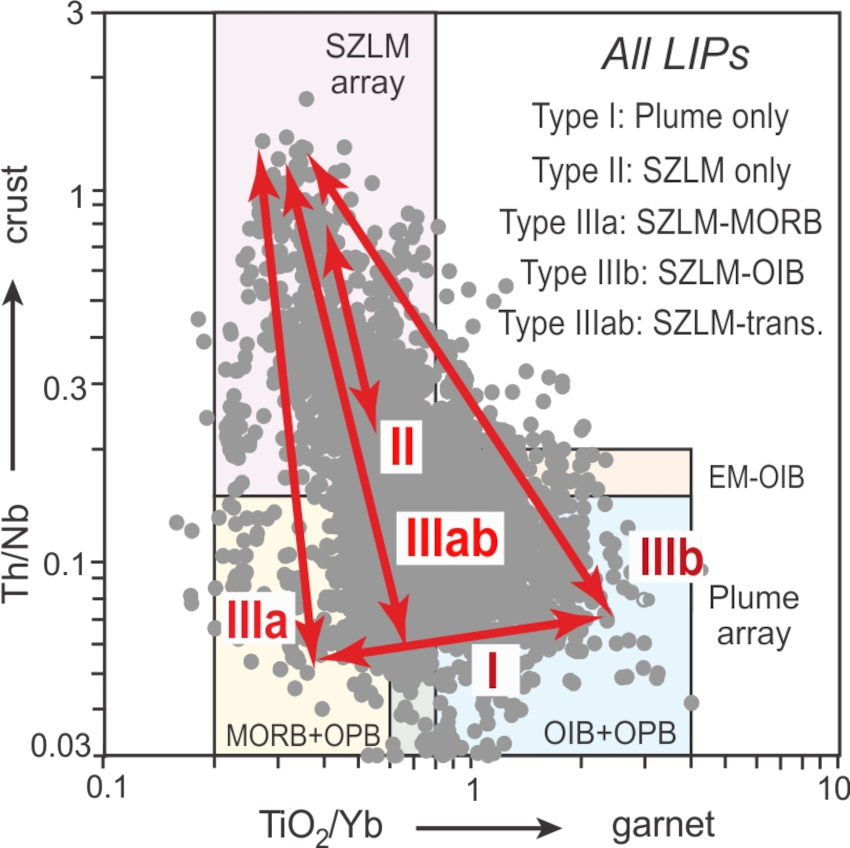June 2021 LIP of the Month
The new LIP-Printing discrimination diagram: Use of immobile element proxies (Th/Nb vs TiO2/Yb) to characterize Large Igneous Provinces in the geologic record
Julian A. Pearce 1, Richard E. Ernst 2,3, David W. Peate 4, Chris Rogers 2
1 School of Earth and Ocean Sciences, Cardiff University, Cardiff CF10 3AT, UK
2 Department of Earth Sciences, Carleton University, Ottawa ON K1S5B6, Canada
3 Faculty of Geology and Geography, Tomsk State University, Tomsk 634050, Russia
4 Department of Earth and Environmental Sciences, University of Iowa, Iowa City, IA 52242, USA
A new diagram for tectonic and petrogenetic fingerprinting of Large Igneous Provinces (LIPs) is introduced in Pearce et al. (2021). This diagram (the ‘LIP printing diagram) uses two immobile element proxies: Th/Nb, a crustal input proxy (to monitor subduction-metasomatism; and crustal assimilation) and Ti/Yb, a residual garnet proxy (to monitor depth and degree of melting). The diagram (Fig. 1) is characterised by two distinct arrays: a subduction-modified lithospheric mantle (SZLM) array and a MORB-OIB-OPB (plume) array (where OPB= oceanic plateau basalt).
Importantly, LIP suites naturally divide into three types on this diagram (Fig. 1D): Type I plots entirely within the MORB-OIB-OPB array (indicative of a significant plume source); Type II plots entirely within the SZLM array (indicative of a significant sub-continental lithospheric mantle source); and Type III plots on a range of trends (IIIa, IIIab and IIIb) between the two arrays (indicative of significant plume-lithosphere interactions, where lithosphere could be mantle, crust or both).
The large genetic, and hence compositional, variability within and between LIPs relates to differences in geological and geodynamic setting and is expressed by each LIP having a distinct pattern, in other words, its own ‘LIP print’.
The potential applications of the LIP printing diagram are illustrated with nearly 40 examples (Figs. 9-11, 14-15) that highlight temporal and spatial LIP print diversity: from Phanerozoic flood basalts, Proterozoic dyke swarms, mineralization-hosted events, early Earth lavas and dykes, and extraterrestrial lavas.
A further aspect of Pearce et al. (2021; Figs. 12-13) is modelling which demonstrates how the three LIP print types (and the observed trends within and between individual LIPs), can be explained by differences in the contributions of lithospheric and asthenospheric (plume) mantle, in temperature and depth of melting, and in the extent and nature of magma-crust interactions.
Note that Pearce et al. (2021) includes two Supplementary files: an Excel file with a template for producing the LIP printing diagram (and related diagrams); and a pdf file containing the compositions and equations needed to model the observed petrogenetic trends.
The paper and its Supplements are available as Open Access through 2021 on https://doi.org/10.1016/j.lithos.2021.106068

Figure 1: The LIP printing diagram consists of a subduction-modified lithospheric mantle (SZLM) and a ‘plume’ array treated as equivalent to the MORB-OIB-OPB (asthenosphere) array. The SZLM array also includes most continental crust. Data for oceanic and continental LIPs are superimposed. (After Figure 8 in Pearce et al. 2021.)
Reference
Pearce, J. Ernst, R.E., Peate, D., Rogers, C. (2021) LIP Printing: Use of Immobile Element Proxies to Characterize Large Igneous Provinces in the Geologic Record. Lithos 392-393, 106068.
